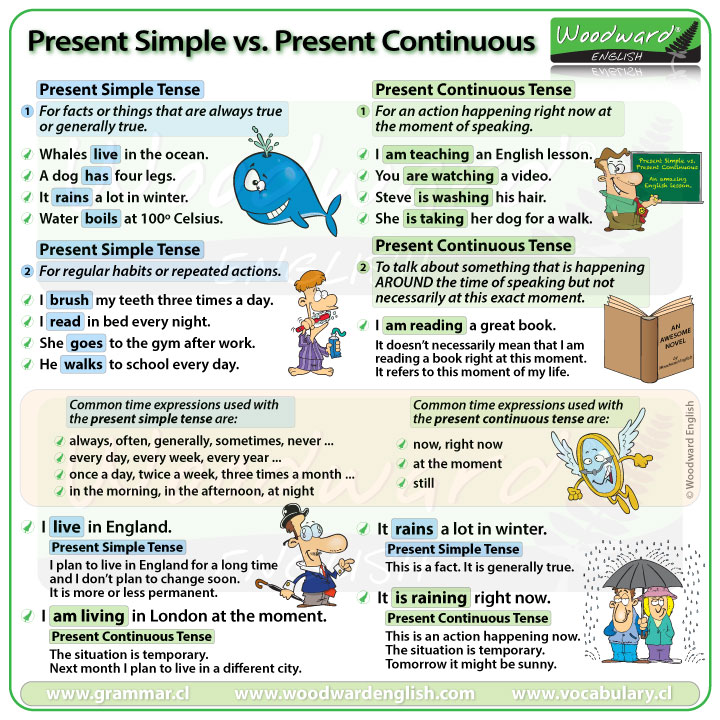Present Simple vs. Present Continuous
- I speak English.
- I am speaking English.
What is the difference?
I speak English – is in the Present Simple tense
I am speaking English – is in the Present Continuous tense
When do we use the Present Simple and when do we use the Present Continuous?
Let’s look at each one…
PRESENT SIMPLE TENSE
We use the present simple tense:
1. For facts or things that are always true or generally true.
- Whales live in the ocean.
(This is a fact, this is always true) - A dog has four legs.
(This is generally true, unfortunately some dogs have three legs or less) - It rains a lot in winter.
(Yes, this is generally true) - Water boils at 100º Celsius.
(This is a fact, just like the fact that water freezes at 0º Celsius)
The present simple tense is also used…
2. For regular habits or repeated actions
These are often daily routines and they happen always, often, generally, every week, etc.
- I brush my teeth three times a day.
- I read in bed every night.
- He walks to school every day.
- She goes to the gym after work.
- I study for two hours every evening.
Common time expressions used with the present simple tense are:
- always, often, generally, normally, usually, sometimes, never …
- every day, every week, every year…
(note the time word is in single form, day, not days.) - once a day, twice a week, three times a month…
(then the rest are four times, five times etc. then A and the time period, a month, a year, a century) - in the morning, in the afternoon, in the evening, at night
(we don’t say in the night) - on Mondays, on Fridays…
(when the day is in plural it refers to all Mondays, all Fridays)
PRESENT CONTINUOUS TENSE
We use the present continuous tense:
1. An action happening right now at the moment of speaking.
When somebody is doing something right now or something is happening right now.
- I am teaching an English lesson. (Yes, that is what is happening right now)
- You are watching a video.
- Steve is washing his hair.
- She is taking her dog for a walk.
- Please be quiet, the baby is sleeping.
- It is snowing right now.
- Listen! The birds are singing.
You can see that these actions are happening right now and they are temporary actions, normally for a short period of time.
2. To talk about something that is happening AROUND the time of speaking but not necessarily at that exact moment.
This action is in progress and hasn’t finished.
- I am reading a great book.
(It doesn’t necessarily mean that I am reading a book right at this moment. It refers to this moment of my life. I have started reading this book and I haven’t finished it)
- They are staying at a local hotel because the roof of their house was damaged during the storm.
(It doesn’t necessarily mean they are at the hotel right at this moment. Maybe they are at work right now or somewhere else. This situation is temporary.)
- Jack is learning Italian.
(It doesn’t necessarily mean he is learning the language right now at a desk with all of his language books. It refers to this moment of his life.)
Common time expressions used with the present continuous are:
- Now, right now, at the moment, still
NOTE: Sometimes the present continuous is called the present progressive in some workbooks or lessons.
Now let’s compare the two tenses together…
Present Simple vs Present Continuous
Here are the sentences from the beginning of this lesson.
- I speak English
- I am speaking
We say I speak English, because it is a fact. I generally speak English. So we use the Present Simple tense.
We say I am speaking English because it refers to what I am doing now. It is a temporary action because in a moment I might start speaking in Spanish. So we use the Present Continuous.
Let’s compare more sentences:
- I live in England.
We use the Present Simple for things that don’t change for a long time. I plan to live in England for a long time and I don’t plan to change soon. It is more or less permanent. But if I say:
- I am living in London at the moment.
I used the present continuous because this situation is temporary. Next month I plan to live in a different city.
Another example:
- It rains a lot in winter.
We use the present simple because this is a fact or is generally true.
- It is raining right now.
We use the present continuous because we are talking about an action that is happening right now. It is in progress. It will not continue forever, it is temporary. Tomorrow it might be sunny.
Compare these two sentences:
- He is biting his nails because he is nervous.
- He always bites his nails when he’s nervous.
The first sentence shows the action that is happening now… he is biting his nails right now.
The second sentence uses the present simple because it is talking about his habit, sometime that he does when he is nervous. Notice how we use the present simple tense with the adverb of frequency, always.
Another example:
- He teaches at a local school.
That is what he does for a job from Monday to Friday every week. This is his routine.
- He is teaching business at the local school this week.
It is possibly a temporary job he has this week because next week he will return to his normal job or maybe he will teach at another school next week.

Affirmative, Negative, Questions
Let’s compare the present simple and present continuous in affirmative sentences, negative sentences and in questions.
Here are two affirmative sentences:
- I eat cereal every day. (This is my habit, my routine)
- I am eating cereal right now. (This is an action happening now)
Let’s look at the negative form:
- I do not eat cereal every day. (No, sometimes I have pancakes for breakfast)
- I am not eating cereal right now. (No, I am eating broccoli)
We use DO NOT or DOES NOT to make negative sentences in the present simple. Remember, we can use the contractions don’t and doesn’t.
We add NOT between to be and the verb to make negative sentences in the present continuous.
And making questions:
- Do you eat cereal every day? (Is this your habit or routine?)
- Are you eating cereal right now? (Is this what you are doing right now?)
We use DO or DOES to make questions in the present simple tense.
We change the order of the subject (pronoun) and the conjugation of the verb To Be when making questions in the present continuous tense.
Questions – Same verbs, different meanings
Questions can have the same verb but its meaning changes depending on if the question is in the present simple or present continuous. For example:
- What do you do? = What is your job?
- What are you doing? = What (action) are you doing at the moment?
- What do you read? = What type of books do you like to read?
- What are you reading? = What is the name of the book you are reading right now?
